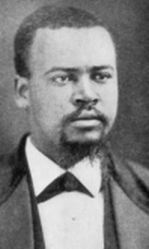Reconstruction
See also: Black and Tan Constitution; Redeemer Democrats; Scalawag; Union League.
Part i: Introduction; Part ii: The Fourteenth Amendment and the Beginning of Congressional Reconstruction; Part iii: Statewide Changes and Achievements during Reconstruction; Part iv: The End of Reconstruction and the Return of Democratic Control; Part v: References
Part III: Statewide Changes and Achievements during Reconstruction
 Republicans dominated the elections of 1867 and the state constitutional convention that followed. The resulting Constitution of 1868 endured for more than a century, albeit with many amendments. It provided for universal manhood suffrage and basic legal rights for whites and blacks alike (complying with congressional mandates) and introduced locally elected county government and a public school system for both races. In April 1868 voters ratified the constitution and elected Republicans to all statewide offices, including Holden as governor and a Republican legislative majority. Blacks won no statewide offices but were elected to many local positions, especially in the east. Northerners were also elected to offices in predominantly black counties in the east, filling a partial vacuum of talent left by the legacy of slavery. Statewide and in most localities, especially in the west, the great majority of Republican officeholders were native whites (scalawags to their enemies).
Republicans dominated the elections of 1867 and the state constitutional convention that followed. The resulting Constitution of 1868 endured for more than a century, albeit with many amendments. It provided for universal manhood suffrage and basic legal rights for whites and blacks alike (complying with congressional mandates) and introduced locally elected county government and a public school system for both races. In April 1868 voters ratified the constitution and elected Republicans to all statewide offices, including Holden as governor and a Republican legislative majority. Blacks won no statewide offices but were elected to many local positions, especially in the east. Northerners were also elected to offices in predominantly black counties in the east, filling a partial vacuum of talent left by the legacy of slavery. Statewide and in most localities, especially in the west, the great majority of Republican officeholders were native whites (scalawags to their enemies).
In office, the Republicans compiled a notable and generally positive record of achievement. The new legislature ratified the Fourteenth Amendment, as Congress required. It elected to the U.S. Senate John Pool, of Elizabeth City, a recent Whig Party gubernatorial candidate, and Joseph C. Abbott, of Wilmington, a former Union army general. The legislature created (but did not adequately fund) the state's first public school system for blacks as well as for whites, adopted a progressive civil law code, reaffirmed the legal and political equality of the races and ratified the Fifteenth Amendment, established the state's first penitentiary, abolished flogging as a punishment for crime, took steps to alleviate economic distress, and dealt as best it could with Democratic terrorism operating through the Ku Klux Klan (KKK). The legislature was a more democratic body than any of its predecessors and, for many years after, its successors. On the other hand, it went beyond the limits of prudence and legality in voting money for railroad construction, most of which never took place; a year later the same legislators had second thoughts and withdrew most of the state aid. A few members took bribes in return for pro-railroad votes, the money emanating from a pair of promoters, George W. Swepson and Milton S. Littlefield. But North Carolina saw less corruption than many other states, North and South.
In terms of legislative voting, blacks and northerners compiled a more radical (or egalitarian) record than native white Republicans. All were more radical than the Conservative (Democratic) minority, but in North Carolina, as in the Upper South generally, radical egalitarianism never extended far beyond the ballot box. (Radical rule was more a Conservative campaign slogan than a reality.) Blacks remained poor, undereducated, and relatively dependent on whites. Few whites of either party favored racial integration; segregation remained the norm in the schools, on the railroads, and in most places of public accommodation. But in contrast to previous regimes, which had excluded blacks from most state institutions and services, Republicans made an effort to provide equal facilities.
Keep reading > Part IV: The End of Reconstruction and the Return of Democratic Control![]()
Educator Resources:
Grade 8: African Americans in the United States Congress During Reconstruction. North Carolina Civic Education Consortium. http://database.civics.unc.edu/files/2012/09/AfricanAmericansUSCongressR...
Grade 8: Exploring African American Leadership and Service in North Carolina. North Carolina Civic Education Consortium. http://civics.sites.unc.edu/files/2012/05/AfricanAmericanLeadershipServi...
Grade 8: From Slavery to Sharecropping. North Carolina Civic Education Consortium. http://civics.sites.unc.edu/files/2012/04/Sharecropping.pdf
Image Credits:
John Hyman U.S. Congressman, 1875-1877. Photo courtesy of the North Carolina Civil War Sesquicentennial, a project of the North Carolina Department of Cultural Resources. Available from http://www.nccivilwar150.com/history/reconstruction.htm (accessed May 3, 2012).
1 January 2006 | Trelease, Allen W.